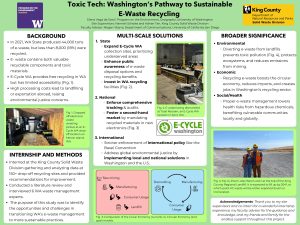Toxic Tech: Washington’s Path to a Sustainable Electronics Recycling System
Over 44,000 tons of electronic waste were produced in Washington in 2021. E-waste contains materials that can be recycled, but the complexity and high cost of recycling processes often prevent electronic waste from being properly managed. The alternatives, like disposal in landfills or exportation abroad, although cheaper, are environmentally, economically and socially harmful. More environmentally sound solutions and systems must be implemented in Washington. The aim of this study was to analyze the challenges and opportunities to improve Washington’s electronic waste management systems. Through my internship with the King County Solid Waste Division, I assessed drop-off recycling sites for e-waste and identified areas for improvement to increase consumer usage. Additionally, I conducted a literature review and interviews with WA experts on waste management to learn how to improve in-state recycling systems and reduce export of waste abroad. Although the main environmental justice implications lie abroad on the communities importing these hazardous materials, this issue can be addressed domestically in two main ways. Firstly, improvement of the current Extended Producer Responsibility and Product Stewardship programs (E-Cycle WA) to increase recycling rates and divert as much electrical waste as possible from landfills. Secondly, a fostered second-hand market through regulation requiring new electronics to contain a percentage of recycled materials. Implementing these changes will have positive economic, environmental, and social implications by creating a more sustainable circular economy, reducing the harmful consequences of pollution in landfills and waste exportation, and supporting local recycling infrastructure.
